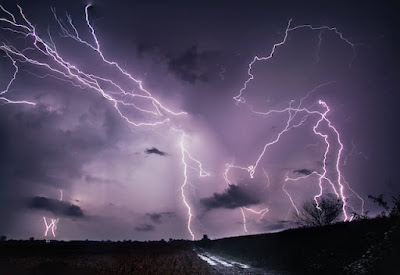Time from seeing lightning to hearing thunder in seconds
miles to you:
kilometers to you:
Lightning is a naturally occurring electrostatic discharge
Lightning is a sudden and powerful electrostatic discharge that occurs within a thunderstorm cloud or between a cloud and the ground. It is a rapid and intense flow of electricity through the atmosphere that generates a bright flash of light. Lightning can be seen as a jagged or branching line of light in the sky.
Thunder is the sound caused by lightning
Thunder, on the other hand, is the sound that is produced by lightning. When lightning occurs, it heats the surrounding air to a very high temperature, causing it to rapidly expand and create a shock wave. This shock wave produces the sound of thunder, which can be heard as a rumbling or booming noise in the distance.
Lightning first then thunder
The reason why we see lightning before we hear thunder is that light travels faster than sound. The light from the lightning reaches our eyes almost instantly, while the sound of thunder travels through the air at a much slower speed. By counting the number of seconds between the flash of lightning and the sound of thunder, we can estimate how far away the lightning struck.
How far away is the lightning when you hear thunder?
To estimate how far away the lightning struck, you can use a simple method based on the speed of sound. Since sound travels at a constant speed through the atmosphere, you can calculate the distance to the lightning by measuring the time delay between seeing the lightning and hearing the thunder. Here are the steps:
When you see the lightning, start counting the number of seconds until you hear the thunder.
How to count distance between lightning and thunder? Divide the number of seconds you counted by 5. This will give you the distance to the lightning in miles, or divide by 3 to get the distance in kilometers.
For example, if you counted 15 seconds between seeing the lightning and hearing the thunder, divide 15 by 5, which gives you 3 miles, or 5 kilometers. This means the lightning struck about 3 miles (or 5 kilometers) away from your location.
Formula to determine lightning distance
Calculate distance of lightning.
Distance (in miles) = Time interval (in seconds) / 5
Distance (in kilometers) = Time interval (in seconds) / 3
Here's how you can use this formula:
When you see a lightning flash, start a timer or count the seconds until you hear the thunderclap.
Stop the timer or count when you hear the thunder.
Use the formula above to calculate the approximate distance to the lightning strike.
For example:
4 seconds between lightning and thunder - 0.852 mi or 1.37 km
5 seconds between lightning thunder - 1.065 mi or 1.72 km
6 seconds between lightning and thunder - 1.278 mi or 2.06 km
8 seconds between lightning and thunder - 1.704 mi or 2.74 km
9 seconds between lightning thunder - 1.917 mi or 3.09 km
Keep in mind that this method only gives you an estimate of the distance to the lightning, as sound waves can be affected by various factors such as wind, temperature, and humidity, which can cause them to travel faster or slower through the atmosphere.
How far away from windows during lightning
Do not stand or sit near windows during a lightning storm. Stay at least a few feet away from windows to avoid the risk of flying glass if lightning were to strike nearby. If you are already inside your home, stay there and avoid going outside until the storm has passed.
Do not use electrical appliances, including computers, corded phones, or any plugged-in devices, during a lightning storm. Lightning can cause power surges that may damage these devices or cause electric shock.
Remember that lightning can be unpredictable and extremely dangerous, so taking precautions to stay away from windows. If your area experiences frequent lightning storms, consider installing lightning rods.


No comments:
Post a Comment